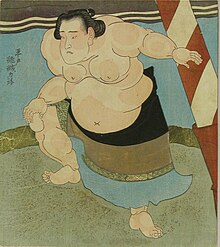Hiodoshi Katsugorō
| Hiodoshi Katsugorō | |
|---|---|
| 緋縅 勝五郎 | |
 Hiodoshi when he was still known as "Hiodoshi Rikiya" (c. 1790-1810) | |
| Personal information | |
| Born | Moriwaki ? 1773 Yamagata District, Aki Province, Japan |
| Died | February 22, 1830 (aged 56–57) |
| Height | 1.77 m (5 ft 9+1⁄2 in) |
| Weight | 116 kg (256 lb) |
| Career | |
| Stable | Tamagaki |
| Record | 149-49-92-13 draws/6 holds |
| Debut | November, 1794 |
| Highest rank | Ōzeki (November, 1814) |
| Retired | February, 1823 |
| Elder name | Akaō |
| * Up to date as of October 2023. | |
Hiodoshi Katsugorō (Japanese: 緋縅 勝五郎, born Moriwaki (森脇), 1773 – February 22, 1830) was a Japanese sumo wrestler from Yamagata District, Aki Province (now Kitahiroshima, Hiroshima Prefecture). His highest rank was ōzeki. He is the first wrestler from Hiroshima Prefecture to have been promoted to sumo's second highest rank, and the only one until the promotion of Akinoumi in 1941, 127 years later.[1]
Career
[edit]All we know of Hiodoshi's true identity is his family name, Moriwaki. He began his career in the Osaka-based sumo association under the patronage of the Awa-Katsuyama Domain but joined the Edo-based association in 1794 and began his career directly in the sandanme division under the shikona, or ring name, Hiodoshi Rikiya (緋縅 力彌).[2] In 1802 he reached the makuuchi division and acquired the patronage of the Morioka Domain. Known as a wrestler with great stamina, he nevertheless remained in the lower ranks of the division for a long time, suffering from his lack of technique and won few matches against top-ranked wrestlers. In 1813, however, he made his debut in the san'yaku status with a promotion to the rank of komusubi.
In 1814, he was promoted back to back to sekiwake and reached the rank of ōzeki, only retaining it for one tournament. However, Hiodoshi had to miss these tournaments and lost his san'yaku status, only regaining it at the end of his career in 1819 before definitively ending his wrestling career as a maegashira. At the time of his repromotion to san'yaku he changed his shikona to Hiodoshi Katsugorō (緋縅 勝五郎). He retired in January 1822, concluding a career of rare longevity (even by today's standards) of 28 years, including 21 in the top division.[2] After his retirement he became an elder and called himself Akaō (赤翁), meaning 'red elder', and trained ōzeki Hiodoshi II, to whom he gave his former shikona and adopted him as his son.[2]
Sumo career record
[edit]- The actual time the tournaments were held during the year in this period often varied.
| - | Spring | Summer | ||||
|---|---|---|---|---|---|---|
| 1800 | East Jūryō #2 2–0 1h |
Unknown | ||||
| 1801 | Sat out | Unknown | ||||
| 1802 | West Maegashira #3 4–1–5 |
West Maegashira #8 7–0–3 |
||||
| 1803 | Unknown | East Maegashira #4 5–1–1 2d-1h |
||||
| 1804 | Unknown | East Maegashira #4 6–2–1 |
||||
| 1805 | Unknown | Unknown | ||||
| 1806 | Unknown | Unknown | ||||
| 1807 | Unknown | East Maegashira #2 8–1 1h |
||||
| 1808 | Sat out | East Maegashira #2 7–1–1 1d |
||||
| 1809 | East Maegashira #1 6–1–1 1d |
East Maegashira #2 4–1–3 1h |
||||
| 1810 | East Maegashira #1 8–2 |
East Maegashira #2 6–2–1 1d |
||||
| 1811 | East Maegashira #1 7–2–1 |
East Maegashira #2 5–2–2 1h |
||||
| 1812 | Unknown | East Maegashira #1 5–2–1 2d |
||||
| 1813 | East Komusubi #1 6–2–1 1d |
East Komusubi #1 5–1–1 2d |
||||
| 1814 | East Sekiwake #1 0–0–10 |
East Ōzeki #1 0–0–10 |
||||
| 1815 | Unknown | East Sekiwake #1 6–2–1 |
||||
| 1816 | East Sekiwake #1 5–2 1h |
East Komusubi #1 4–3–1 1d |
||||
| 1817 | East Komusubi #1 4–3–2 |
East Maegashira #2 6–2 1d |
||||
| 1818 | East Komusubi #1 5–2–2 |
East Maegashira #1 4–2–2 |
||||
| 1819 | West Komusubi #1 4–1–5 |
West Komusubi #1 4–3–1 |
||||
| 1820 | West Komusubi #1 2–1–3 |
West Maegashira #1 6–2–1 |
||||
| 1821 | West Maegashira #1 5–3–2 |
West Maegashira #2 3–2–3 |
||||
| 1822 | West Maegashira #3 Retired 0–0–10 |
x | ||||
| Record given as win-loss-absent Top Division Champion Top Division Runner-up Retired Lower Divisions Key:d=Draw(s) (引分); h=Hold(s) (預り) |
||||||
*Championships for the best record in a tournament were not recognized or awarded before the 1909 summer tournament and the above championships that are labelled "unofficial" are historically conferred. For more information see yūshō.
See also
[edit]References
[edit]- ^ "Wrestlers from Hiroshima Prefecture by rank". Sumo Reference. Retrieved 12 October 2023.
- ^ a b c "大関伝 93人目~103人目 - 97人目 緋縅 力弥". Atsuo Tsubota Database (in Japanese). Archived from the original on 8 December 2014. Retrieved 13 October 2023.
- ^ "Hiodoshi Rikiya Rikishi Information". Sumo Reference.
